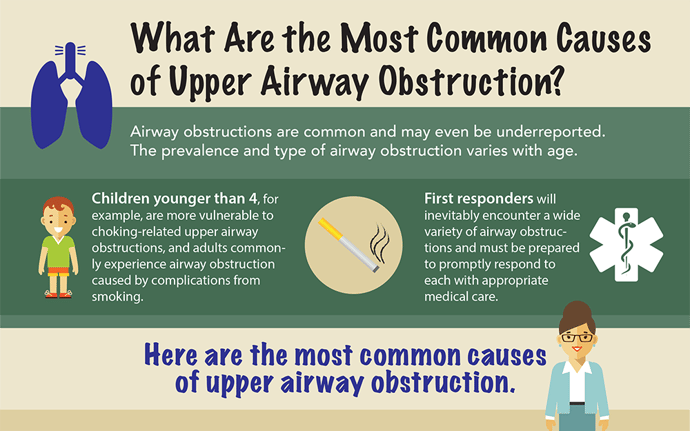
Airway obstructions are common. The prevalence and type of airway obstruction varies with age. Children younger than four are more vulnerable to choking-related upper airway obstructions, while adults commonly experience airway obstruction caused by complications from smoking. First responders will inevitably encounter a wide variety of airway obstructions and must be prepared to promptly respond to each with appropriate medical care. Here are the most common causes of upper airway obstruction.
Tongue-Related Airway Obstruction
A relaxed tongue is the most common cause of upper airway obstruction in patients who are unconscious or who have suffered spinal cord or other neurological injuries. In some cases, other injuries complicate this phenomenon – a patient who is unconscious following a blow to the head may also have suffered upper airway trauma, causing both the tongue and the trauma to block the airway.
Foreign Body/Choking
The most common cause of airway obstruction in children is a foreign body lodged in the airway. Choking can fully or completely obstruct the airway. Small toys, round foods such as berries and grapes, rocks, pebbles, and other enticing objects are common culprits. A study showed that from 2001 to 2016, 73% of nonfatal injuries and 75% of choking fatalities occurred in children under age five.
Swelling
Swelling can obstruct the airway in a matter of seconds, and though infections can cause severe upper airway swelling, the most common cause is anaphylaxis. Anyone with an allergy can have an anaphylactic reaction, even if they have been previously exposed to the allergen without such an extreme reaction. About 20 million Americans have food allergies, putting millions at risk of swelling-related airway obstructions. Moreover, the prevalence of food allergies is increasing: there’s been a 21% increase in peanut allergies in children since 2010.
Asthma may also cause upper airway swelling. In most cases, asthma is well-managed with a rescue inhaler, but severe asthmatic reactions can be fatal. About 27 million Americans have asthma, and about 10 people die from asthma daily.
Infection
Infections such as pneumonia, RSV, Covid, and colds may obstruct the upper airway. Children are more vulnerable because of their smaller airways. In newborns, upper airway obstructions, even partial ones, are particularly dangerous because newborns can only breathe through the nose. People with chronic respiratory diseases such as COPD also face a higher risk of infectious upper airway obstructions.
Trauma
Traumatic injuries can directly obstruct the airway, such as when a gunshot or knife wound collapses portions of the airway. Trauma can also cause continuous bleeding or vomiting that obstructs the airway, making airway management difficult and increasing the risk of aspiration pneumonia. In the latter scenario, continuous suction via the SALAD technique can clear the airway and lower mortality risk.
Traumatic brain and spinal cord injuries may also lead to upper airway obstruction. If a patient cannot clear their own airway, they may require suctioning. In some cases, brain and spinal cord injuries inhibit the brain’s ability to control breathing, coughing, and other important respiratory functions.
Proper management of upper airway obstruction is key to stabilizing the patient for transport and potentially saving their life. Portable suction ensures you can immediately attend to the patient. In the case of unstable patients for whom movement may be risky, such as spinal cord injury survivors, this can improve outcomes. For help selecting the right portable emergency suction device for your agency, download our free guide, The Ultimate Guide to Purchasing a Portable Emergency Suction Device.
Editor's Note: This blog was originally published in July 2022. It has been re-published with additional up to date content.
















